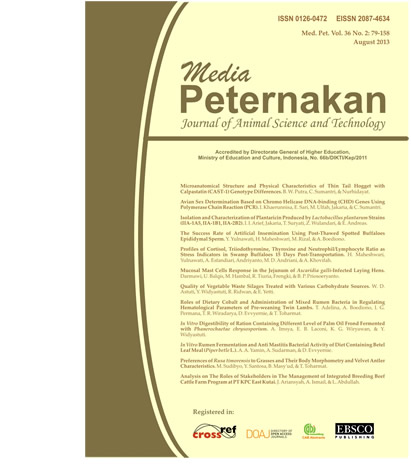In Vitro Rumen Fermentation and Anti Mastitis Bacterial Activity of Diet Containing Betel Leaf Meal (Piper betle L.)
Abstract
The aims of this experiment was to study the inhibition effect of betel leaf meal (BLM) addition into concentrate diet on mastitis causing bacteria and on rumen fermentation condition. The study consisted of five dietary treatments of BLM level in concentrate feed, i.e., 0%, 2%, 4%, 6%, and 8% and four replicates of each treatment. The treatment diets together with napier grass in ratio of 40 : 60 were fermented using rumen liquor. All treatments were examined their antibacterial activity before and after fermentation. After four hours fermentation, supernatant of each samples were analyzed for VFA, NH3, number of bacteria and protozoa. Dry matter (DM) and organic matter (OM) digestibility were analyzed after 48 h fermentation. The results showed that before fermentation, 8% BLM addition caused the bigest (P<0.05) inhibition diameter of Staphylococcus spp. growth compared to other lower levels. However after fermentation there were no significant differences among the addition levels of BLM. Two per cent of BLM addition produced higher VFA (P<0.05) than the other addition levels. Ammoniaconcentration, dry matter (DM) and organic matter (OM) digestibility were not different among the treatments. Addition of BLM significantly (P<0.01) decreased protozoa number, but did not affect bacterial count. It is concluded that the addition of 2% BLM in concentrate feed can be used effectively to inhibit the growth of mastitis causing bacteria (Staphylococcus spp.) and does not disturb rumen fermentation condition.



